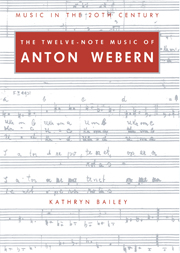Book contents
- Frontmatter
- Contents
- Acknowledgements
- Conventions in the text
- Introduction
- PART I Row and canon
- PART II The instrumental music
- PART III The music with voices
- Introduction to Part III
- 8 Das Augenlicht
- 9 Cantata I
- 10 Cantata II
- Conclusion
- Appendices
- Notes
- Glossary
- Chronological worklist
- Select bibliography
- Index
Introduction to Part III
Published online by Cambridge University Press: 23 December 2009
- Frontmatter
- Contents
- Acknowledgements
- Conventions in the text
- Introduction
- PART I Row and canon
- PART II The instrumental music
- PART III The music with voices
- Introduction to Part III
- 8 Das Augenlicht
- 9 Cantata I
- 10 Cantata II
- Conclusion
- Appendices
- Notes
- Glossary
- Chronological worklist
- Select bibliography
- Index
Summary
After Op. 19 the only texts set by Webern were those written by his friend Hildegard Jone. The resulting works – the songs Opp. 23 and 25, Das Augenlicht and the two cantatas – were a testament to a friendship that dominated – aesthetically, at least – the later years of Webern's life. Jone's strange mystical/Christian poetry with its rapturous metaphors and allusions to nature found a kindred spirit in the naïve but intense composer who customarily outlined the movements of projected works in his sketchbooks by making associations with favourite alpine flowers and mountain retreats. His letters to the poetess are filled with exclamations of unexpected delight in having found time and again in her poetry the expression of his own thoughts. Clearly personal affection also influenced his view of her poetry and his exclusive use of it as texts for all the late works, but this is not an alternative explanation for his choice, because of course the friendship itself was a product of the close affinity of these two minds and sensibilities. It is at first surprising, nevertheless, to find a composer who for his early songs found his texts in Goethe, Rilke, Strindberg and Stefan George to turn in all his late works to a relatively unknown writer with an eccentric style. Isee Webern's exclusive choice of Jone texts as significant in a wider context: Webern, whose twelve-note music has been variously described as more classical, less intense and more cerebral than that of Schoenberg and Berg, seems to have been, ironically, of the three composers the one with the least wisdom concerning the ways of the world and the least discernment with respect to the other arts.
- Type
- Chapter
- Information
- The Twelve-Note Music of Anton WebernOld Forms in a New Language, pp. 265 - 267Publisher: Cambridge University PressPrint publication year: 1991



